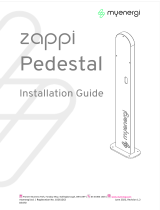
Page 11 of 32
8.4 CT Sensor Installation
Current Transformers (CTs) are used to measure current at various places of the installation. For example, the
Grid connection point, the solar/wind inverter or a static battery system.
Installation of a CT to monitor the Grid connection point is required. Other CTs are optional and can be
purchased separately. The number and location of CTs used within an installation will vary according to devices
installed and the user requirements.
CTs can be wired to any myenergi device with CT inputs (e.g. eddi, zappi or harvi). This enables very flexible
installation as the CT can be wired to the nearest device. Note: The harvi device can be used if it is not practical
to connect any CT to the eddi.
8.4.1 Grid CT
The Grid CT sensor (supplied) needs to be clipped around either
the Live or Neutral meter tail of the electricity supply meter. If
using the Neutral conductor, reverse the direction of the sensor
(so the arrow is reversed).
The black and red wires need to be inserted into the CT terminal of
the
eddi
(as per image adjacent). Do this using a terminal
screwdriver to push in the white plunger and then insert the wire
into the respective hole (black to [-], red to [+]).
The positioning of the Grid CT sensor is crucial, take note of the
following when deciding where best to install the sensor:
• Can be connected to any myenergi device with a CT
input e.g. the eddi or zappi (wired sensor) or harvi
(wireless sensor).
• ALL of the imported and exported power must be
'seen' by the sensor – be sure to install it upstream of
ANY junction box or 'Henley Block' (the CT can be
fitted inside the consumer unit).
• There must be only one Grid CT per-phase for the
whole installation. (There can be other CTs but only
one at the grid connection point, also note CTs for
third-party devices do not matter).
• The CT should be on the Live or Neutral cable.
• The arrow on the sticker of the CT sensor must be pointing towards the consumer unit (in the
direction of grid import) if on the Live cable, or reversed if on the Neutral cable.
• Ensure the CT is fully closed and clicks shut.
• Be sure to wire the CT the correct way round; black [–], red [+] otherwise import and export
readings will be swapped.
8.4.2 Additional CTs
There is an option to add other CT sensors (available separately) for monitoring the generation or other
appliances such as battery systems. Installing a CT for the generator (PV system) will allow the main screen to
show the generated power and the total power consumption of all the other appliances in the property.
CTs can also be used to limit the power drawn from the supply:
• Additional CTs can be connected to any myenergi device with a CT input that is linked to the
network
• The arrow on the sticker of the sensor must be pointing in the direction of normal power flow (e.g.
away from the PV inverter) if on the Live cable or reversed if on the Neutral cable.
• Ensure the sensor is fully closed and clicks shut.
• Be sure to wire the CT the correct way round; black [–], red [+]
If a myenergi zappi EV Charger is configured it is not G100 compliant to use a harvi to measure grid CT,





























